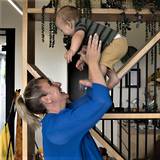Teaching kids to ride their first bike
|
Learning to ride a bike is quite a milestone in a child’s life. When you start to teach them is up to you, with some kids starting to learn as early as 3 years old. Generally though it’s usually around their 4th or 5th birthday or sometimes even later. Follow these easy steps to help them on their way.
|
You might also be interested in ...
Becoming a new mum in your 40s – a real life story
So what’s it like to become a new mum when you’re over the age of 40? As women are having babies later and later in life these days, the chances of becoming a first time mum when you’re over 40 is more evident than it used to be. Read this beautiful real account of becoming a mum in your 40s from New Shoots owner, Nikki Prendergast.
Managing parents separation anxiety
It’s not uncommon for young children to suffer from separation anxiety, but parents separation anxiety is common too, especially when it comes to leaving their little one for the first few times. Check out these tips on how to manage separation anxiety and make leaving your child a little bit easier.







When you start to teach them is up to you, with some kids starting to learn as early as 3 years old.
Generally though it’s usually around their 4th or 5th birthday or sometimes even later.
The process is often made easier for those who have previously used a balance bike (one without pedals), as it helps them to learn balance and pushing themselves forward.
Follow these easy steps to help them on their way.
Step 1 - Preparation
Step 2 - Location
Step 3 - Learning to stop
Step 4 - Understanding steering
Step 5 - Managing your expectations
Step 6 - Remember to have fun
Like the article you've just been reading? Click on the Refer A Friend link at the top of the page and send the details to friends who might like to read it too.Tell your friends
More Hot Topics for you to enjoy
- Benefits of trampolining for kids
- Scooter buying guide and safety tips for toddlers
- Christmas present ideas for 0-5 year olds
Image source: bikestylespokane.com